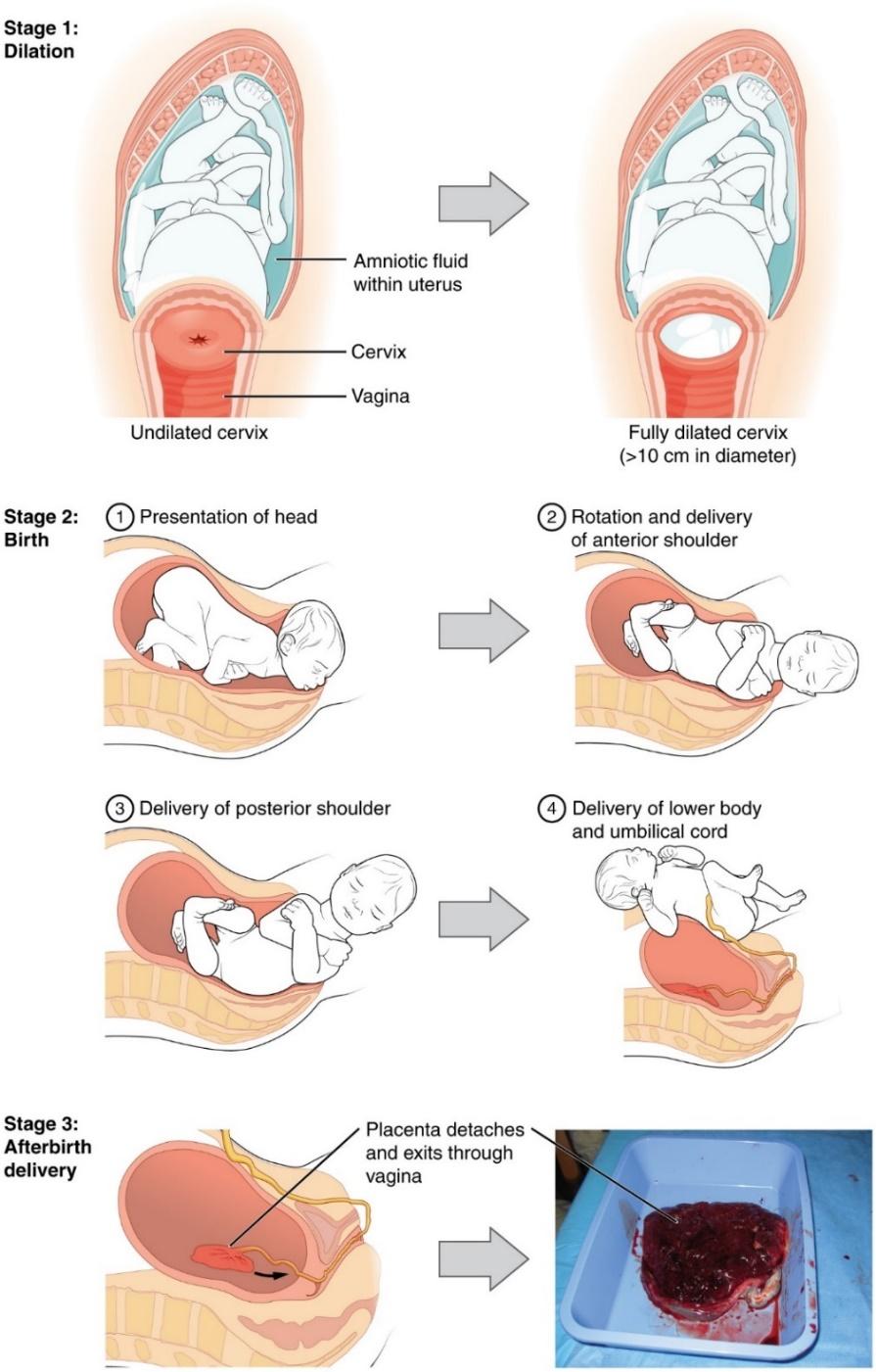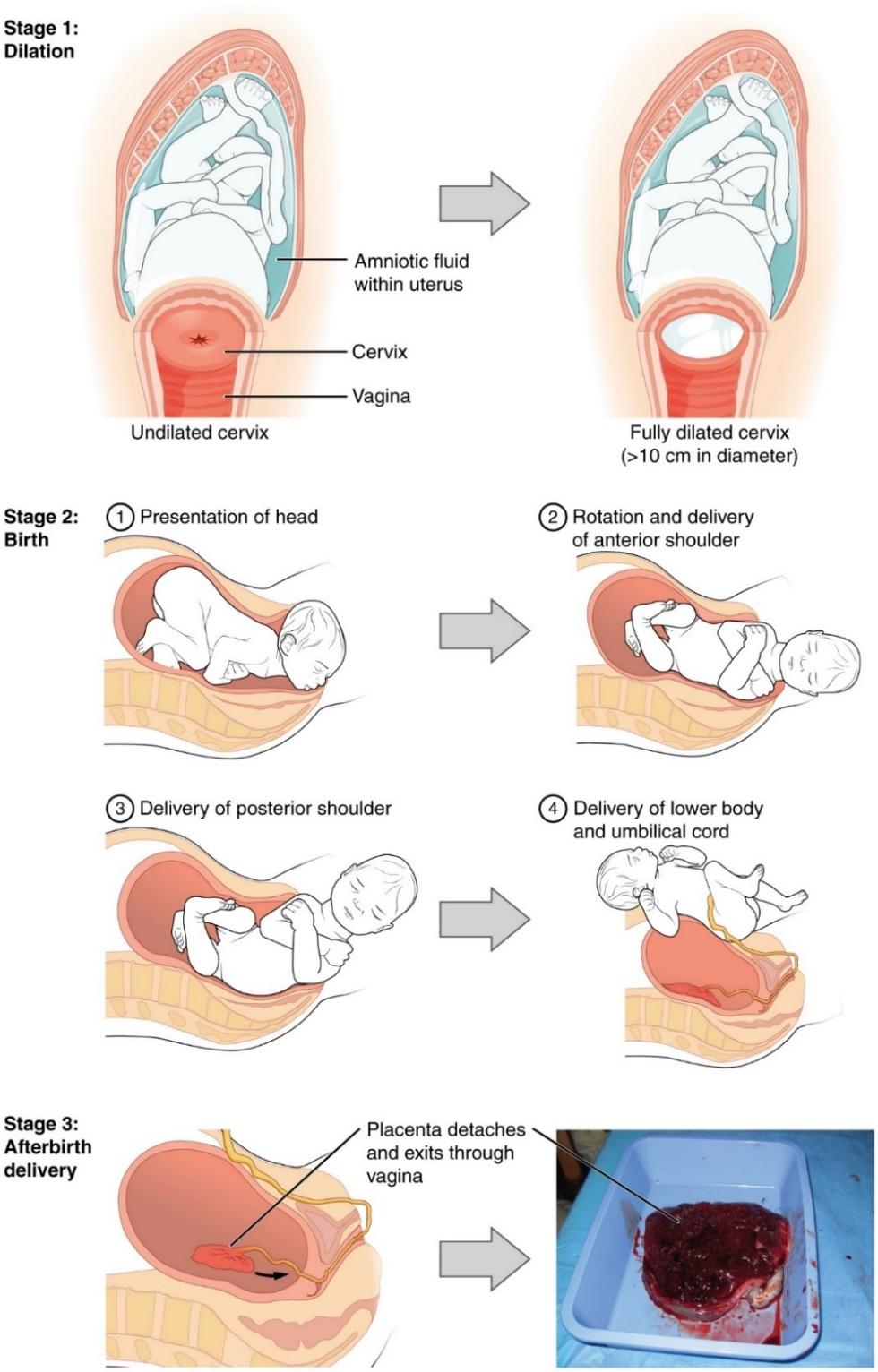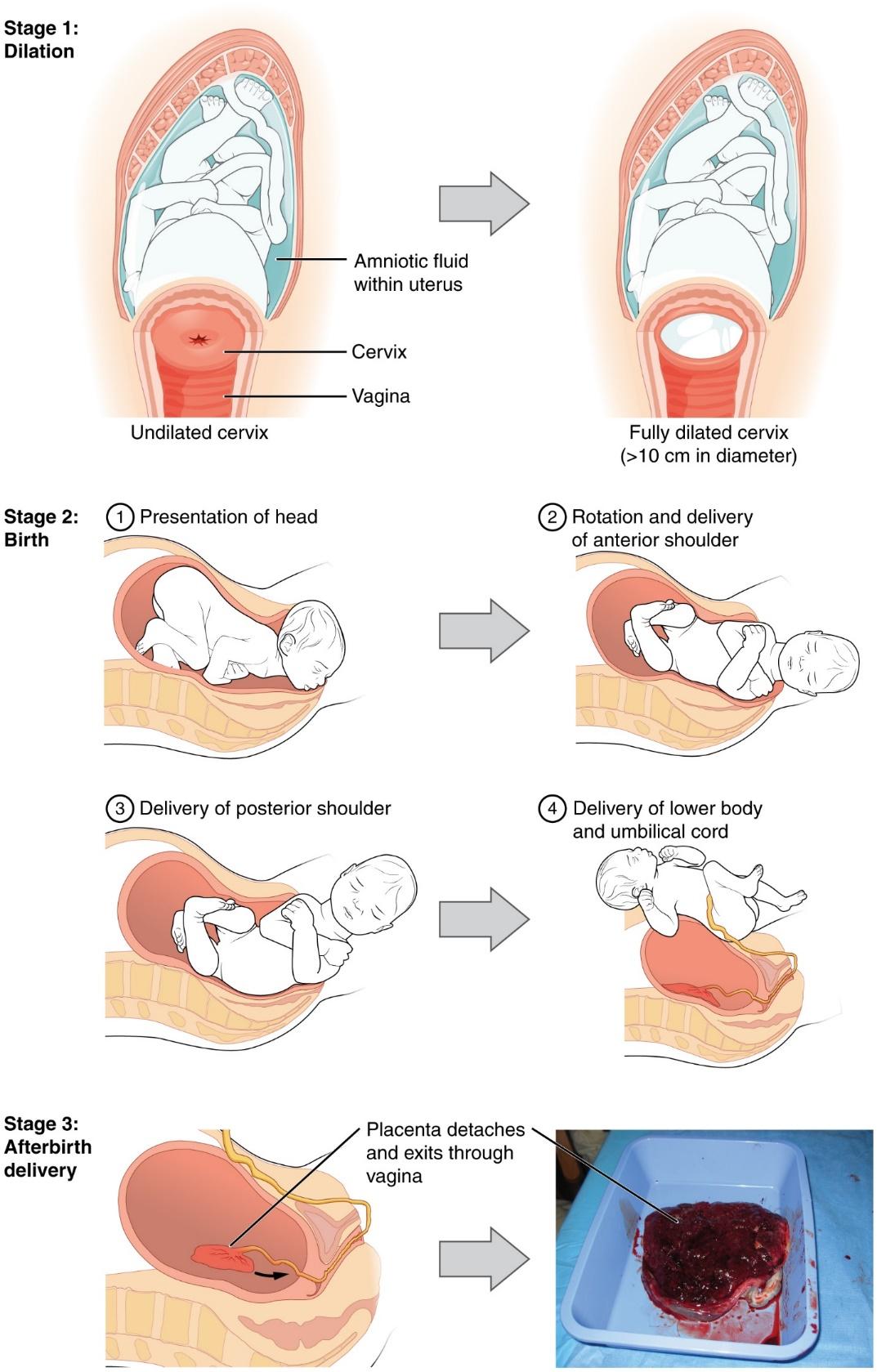4.2 Stages of Childbirth
Giving birth is a unique and personal experience. Nearly everyone who has gone through the physical experience of delivering a child has their own story. Yet, the stages of childbirth generally occur in a consistent order. One of the amazing things about pregnancy and delivery is how unique and individual this very common experience can be. In this chapter we will learn about the stages of childbirth and delivery. We will cover vaginal delivery, cesarean section, as well as premature labor, and stillbirths. Though we begin with the stages of vaginal delivery, it is important to consider that two of every five live birth deliveries result in a C-section. Some of the information in this section will not align with the experiences of live birth for approximately forty percent of the population.
4.2.1 Preparing for and onset of labor
In a typically developing pregnancy, an expectant mother carries a baby between 37-40 weeks. Most of the time, labor will begin within a week of the due date. However, if a woman is pregnant with more than one fetus, or if a health issue prevents a full term pregnancy for the safety of mother or child, labor may begin early on its own, or be induced. However, there are some things women can do to increase the chances of a healthy, on time delivery. For example, maintaining good physical condition reduces risks of premature labor. Childbirth classes can help parents prepare for the experience of labor and delivery, such as creating a childbirth plan, as well as what to expect once home from the hospital. See the breakout box titled “Birth Classes and Education” for more information on the variety of ways to prepare for childbirth.
As the due date approaches, hormonal changes prepare the body to begin labor. Changes to the cervix help for a vaginal delivery. The “bloody show” is a term used to describe the discharge of a small amount of blood-tinged mucus from the cervix during labor. It usually occurs as the cervix begins to soften, thin out, and dilate in preparation for childbirth. The mucus plug that forms in the cervix during pregnancy is released, which can cause a small amount of bleeding.The bloody show is often considered to be a sign that labor is imminent, although it can occur several days before labor begins.
As labor nears, the mother’s pituitary gland produces oxytocin. This begins to stimulate stronger, more painful uterine contractions, which—in a positive feedback loop—stimulate the secretion of prostaglandins from fetal membranes. Like oxytocin, prostaglandins also enhance uterine contractile strength. The fetal pituitary gland also secretes oxytocin, which increases prostaglandins even further.
4.2.2 Birth Classes and Education
There are several types of childbirth classes available, and the content of each class may vary depending on the instructor or organization offering the course. However, here are some of the most common types of childbirth classes:
- Lamaze classes: Lamaze is a well-known childbirth education method that teaches breathing and relaxation techniques to manage pain during labor. Lamaze classes also provide information on labor and delivery, including medical interventions and pain relief options.
- Bradley method classes: The Bradley method emphasizes natural childbirth and encourages active participation by the partner. The classes cover nutrition, relaxation techniques, exercise, and informed decision-making during labor and delivery.
- Hypnobirthing classes: Hypnobirthing classes teach self-hypnosis techniques to help women achieve a more comfortable and relaxed labor and delivery. The classes also cover information on the physiology of birth, medical interventions, and informed consent.
- Childbirth preparation classes: These classes cover a range of topics related to labor and delivery, including pain management, medical interventions, breathing and relaxation techniques, and breastfeeding.
- Online childbirth classes: Online classes are becoming more popular, especially during the COVID-19 pandemic. They may cover the same topics as traditional in-person classes, but offer the convenience of being able to complete the course from home.
There are many factors to consider in choosing a childbirth education class. As described, each class has a slightly different approach to preparing for birth and transition into parenthood. It’s a good idea to find a class that aligns with the priorities of an expecting mother’s birth plan.
4.2.3 The First Stage
The first stage of labor is the longest stage and begins with the onset of regular contractions and ends when the cervix is fully dilated to 10 centimeters. This stage is further divided into three phases: early, active, and transition (Hutchinson, et al. 2022).
Early labor: This phase is characterized by mild, irregular contractions that may be spaced 10 to 20 minutes apart and last for about 30 to 45 seconds. The cervix begins to thin out and open up, or dilate, to about 3 to 4 centimeters. This phase can last for several hours or even days, and the contractions may become more frequent and intense over time.
Active labor: During this phase, contractions become stronger, more regular, and closer together, typically occurring every 3 to 5 minutes and lasting for about 45 to 60 seconds. The cervix continues to dilate rapidly, reaching 7 to 8 centimeters. The mother may experience increased discomfort and require more support from her birth team during this phase.
Transition: This is the final and most intense phase of the first stage of labor, during which the cervix dilates from 8 to 10 centimeters. Contractions become very strong, lasting for up to 90 seconds and occurring every 2 to 3 minutes. The mother may feel overwhelmed and exhausted during this phase, but it is also a sign that she is nearing the end of the first stage of labor and getting closer to pushing the baby out.
Throughout the first stage of labor, the mother’s healthcare provider will monitor her progress and the baby’s well-being through frequent pelvic exams and fetal heart rate monitoring. Pain management options may also be offered to the mother, including breathing and relaxation techniques, hydrotherapy, and medication.

Figure 4.1. Early cervical dilation.
4.2.4 The Second Stage
The second phase of labor is also known as the “pushing” stage and typically begins when the cervix is fully dilated (10 centimeters) and ends with the birth of the baby. This phase can last anywhere from a few minutes to a few hours, and it is marked by strong contractions and the active pushing of the baby through the birth canal.
During this phase, the mother will be coached by healthcare providers to push during contractions, bearing down as if having a bowel movement, while holding her breath. The mother may also be encouraged to change positions to help facilitate the baby’s descent and minimize tearing.
As the baby’s head crowns, the healthcare provider may perform an episiotomy, which is a surgical cut to widen the vaginal opening, or use perineal massage to help prevent tearing. Once the baby’s head is delivered, the healthcare provider will suction the baby’s mouth and nose to clear any mucus or amniotic fluid and will guide the baby’s shoulders and body out of the birth canal.
Once the baby is born, the healthcare provider will clamp and cut the umbilical cord, and the baby will be placed on the mother’s chest for skin-to-skin contact. The healthcare provider will then assess the baby’s breathing and overall health before delivering the placenta, which marks the end of the second stage of labor.

Figure 4.2. Full dilation and expulsion of the newborn.
4.2.5 The Third Stage
The third stage of labor is the final stage of childbirth, which occurs after the delivery of the baby. This stage is marked by the delivery of the placenta, which is the organ that provides oxygen and nutrients to the developing baby in the womb.
During the third stage of labor, the uterus continues to contract, which helps to detach the placenta from the uterine wall. The mother may feel mild to strong contractions during this time, and there may be some discomfort or pressure.
Once the placenta has detached from the uterus, the mother will need to push to deliver it. The doctor or midwife may gently tug on the umbilical cord to help the placenta come out. The placenta is examined to ensure that it is complete and healthy.
It is important to note that the third stage of labor can be associated with some risks, such as heavy bleeding or retained placenta. Therefore, healthcare providers monitor the mother closely during this stage to ensure that any potential complications are identified and treated promptly.

Figure 4.3. Delivery of the placenta and associated fetal membranes.
